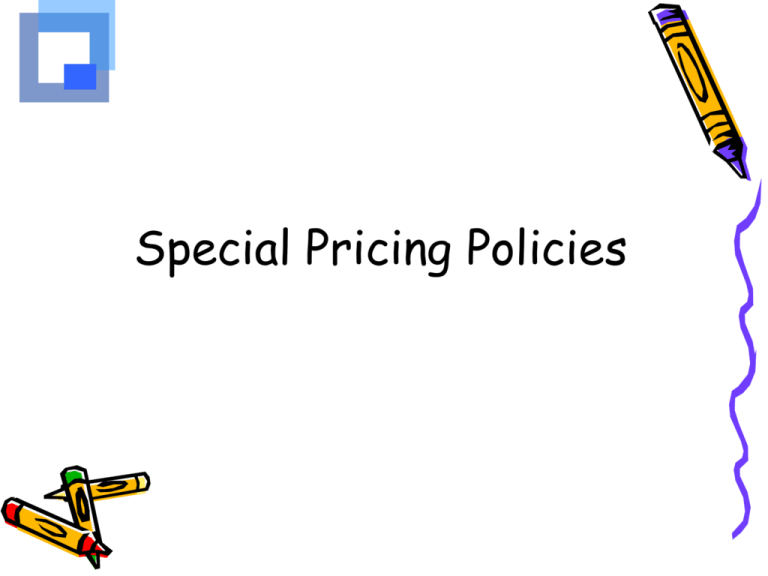Price discrimination
advertisement

Special Pricing Policies Overview Cartel arrangements Price leadership Revenue maximization Price discrimination Nonmarginal pricing Multiproduct pricing Transfer pricing Learning objectives analyze cartel pricing illustrate price leadership see how price discrimination affects output and prices Learning objectives • distinguish between marginal pricing and ‘cost-plus’ pricing • discuss the various types of multiproduct pricing • explain how a company can use transfer pricing Overview I. Basic Pricing Strategies – Monopoly & Monopolistic Competition – Cournot Oligopoly II. Extracting Consumer Surplus – Price Discrimination – Block Pricing Two-Part Pricing Commodity Bundling III. Pricing for Special Cost and Demand Structures – Peak-Load Pricing – Cross Subsidies – Transfer Pricing Price Matching Brand Loyalty Randomized Pricing IV. Pricing in Markets with Intense Price Competition Cartel Agreement among competing firms to fix prices, output and marketing. Occurs in oligopoly markets Can be explicit or Implicit Legal or illegal • illegal in the US: Sherman Antitrust Act, 1890 • examples: OPEC, IATA Cartel arrangements • In order to maximize profits, the cartel as a whole should behave as a ‘monopolist’ the cartel determines the output which equates MR = MC of the cartel as a whole the MC of the cartel as a whole is the horizontal summation of the members’ marginal cost curves price is set in the normal monopoly way, by determining quantity demanded where MC=MR and deriving P from the demand curve at that Q Pricing Strategies Price leadership • Barometric price leadership – one firm in an industry will initiate a price change in response to economic conditions – the other firms may or may not follow this leader – leader may vary Price leadership • Dominant price leadership – one firm is the industry leader – dominant firm sets price with the realization that the smaller firms will follow and charge the same price – can force competitors out of business or buy them out under favorable terms – could result in investigation under Sherman Anti-Trust Act PRICE ELASTICITY AND PROFIT MAXIMIZING PRICE Raise price you will lose sales? Not necessarily if you know your price elasticity of demand UNIFORM PRICING: - Seller charges same price for every unit of the product. Lerner index = p-mc/p To maximize profits, firm should charge a price such that the LI = -1/price elasticity. Suppose the MC = 800. And firms price elasticity is -1.5 Then to maximize profits (MR=MC), firm should charge (p-800/p) = -1/-1.5= 2/3 p = 2400 Shortcomings of uniform pricing Only the marginal buyer has a benefit = price. All other (inframarginal) buyers, have benefits that exceed price = buyer surplus Firm can increase profits by exploiting these surpluses Price discrimination • Price discrimination: products with identical costs are sold in different markets at different prices the ratio of price to marginal cost differs for similar products Conditions for price discrimination – the markets in which the products are sold must by separated (no resale between markets) – the demand curves in the market must have different elasticities Price discrimination • First degree (or perfect) price discrimination – seller can identify where each consumer lies on the demand curve and charges each consumer the highest price the consumer is willing to pay – allows the seller to extract the greatest amount of profits – requires a considerable amount of information • Implication: Charge different price for each additional unit in each market • In practice, transactions costs and information constraints make this difficult to implement perfectly (but car dealers and some professionals come close). Price discrimination • Second degree price discrimination – differential prices charged by blocks of services – requires metering of services consumed by buyers • Implication:- block or quantity discounts • Different prices for different incremental units in each market • Third degree (or simple) price discrimination – customers are segregated into different markets and charged different prices in each – segmentation can be based on any characteristic such as age, location, gender, income, etc Implication:Multi-market price discrimination Different prices in each market • Examples of 3rd degree price discrimination • doctors • telephone calls • theaters • hotel industry Price discrimination • Examples of price discrimination • doctors • telephone calls • theaters • hotel industry More on Simple Price Discrimination • Two conditions are necessary: 1. Separable markets 2. Different substitutability (price elasticity of demand) If demand is less elastic in market A but more elastic in market B, for profit maximization MRa = MRb =MC Price-cost markup is higher in A than in B price is higher in A than in B Price Discrimination comes in Many Variations - Product is tied to sale of complements – tying arrangement - Some customers receive reimbursements - Different products sold to different customers (Versioning) - A higher price for a specified low quantity, a lower price for a specified higher quantity - Different prices to different customers screened by qualification Price Discrimination comes in Many Variations (2) - Different prices of x over time (intertemporal price discrimination) - Same price, but changing attributes over time (product sequencing) Nonmarginal pricing • Cost-plus pricing: price is set by first calculating the variable cost, adding an allocation for fixed costs, and then adding a profit percentage or markup Problems with cost-plus pricing • calculation of average variable cost • allocation of fixed cost • size of the markup Other pricing practices • Price skimming – the first firm to introduce a product may have a temporary monopoly and may be able to charge high prices and obtain high profits until competition enters • Penetration pricing – selling at a low price in order to obtain market share Other pricing practices • Prestige pricing – demand for a product may be higher at a higher price because of the prestige that ownership bestows on the owner • Psychological pricing – demand for a product may be quite inelastic over a certain range but will become rather elastic at one specific higher or lower price Two-Part Pricing • When it isn’t feasible to charge different prices for different units sold, but demand information is known, two-part pricing may permit you to extract all surplus from consumers. • Two-part pricing consists of a fixed fee and a per unit charge. – Example: Athletic club memberships. How Two-Part Pricing Works Price 1. Set price at marginal cost. 2. Compute consumer surplus. 3. Charge a fixed-fee equal to consumer surplus. Fixed Fee = Profits = $16 10 8 6 Per Unit 4 Charge MC 2 D 1 2 3 4 5 Quantity Block Pricing • The practice of packaging multiple units of an identical product together and selling them as one package. • Examples – Paper. – Six-packs of soda. – Different sized of cans of green beans. Commodity Bundling • The practice of bundling two or more products together and charging one price for the bundle. • Examples – – – – Vacation packages. Computers and software. Film and developing. Cable television – MTV and Learning Channel Peak-Load Pricing • When demand during peak times is higher than the capacity of the firm, the firm should engage in peak-load pricing. • Charge a higher price (PH) during peak times (DH). • Charge a lower price (PL) during off-peak Price MC PH DH PL MRH MRL QL DL Q H Quantit y Cross-Subsidies • Prices charged for one product are subsidized by the sale of another product. • May be profitable when there are significant demand complementarities effects. • Examples – Browser and server software. – Drinks and meals at restaurants. Pricing in Markets with Intense Price Competition • Price Matching – Advertising a price and a promise to match any lower price offered by a competitor. – No firm has an incentive to lower their prices. – Each firm charges the monopoly price and shares the market. • Randomized Pricing – A strategy of constantly changing prices. – Decreases consumers’ incentive to shop around as they cannot learn from experience which firm charges the lowest price. – Reduces the ability of rival firms to undercut a firm’s prices. Cannibalization Occurs when sale of one product reduces the demand for another product with a higher incremental margin e.g. business travelers flying on restricted economy class fares wealthy families buying basic sedans instead of high end luxury cars • Fundamental reason for cannibalization is that seller cannot discriminate directly. • The discriminating variable does not perfectly separate the buyer segments.





